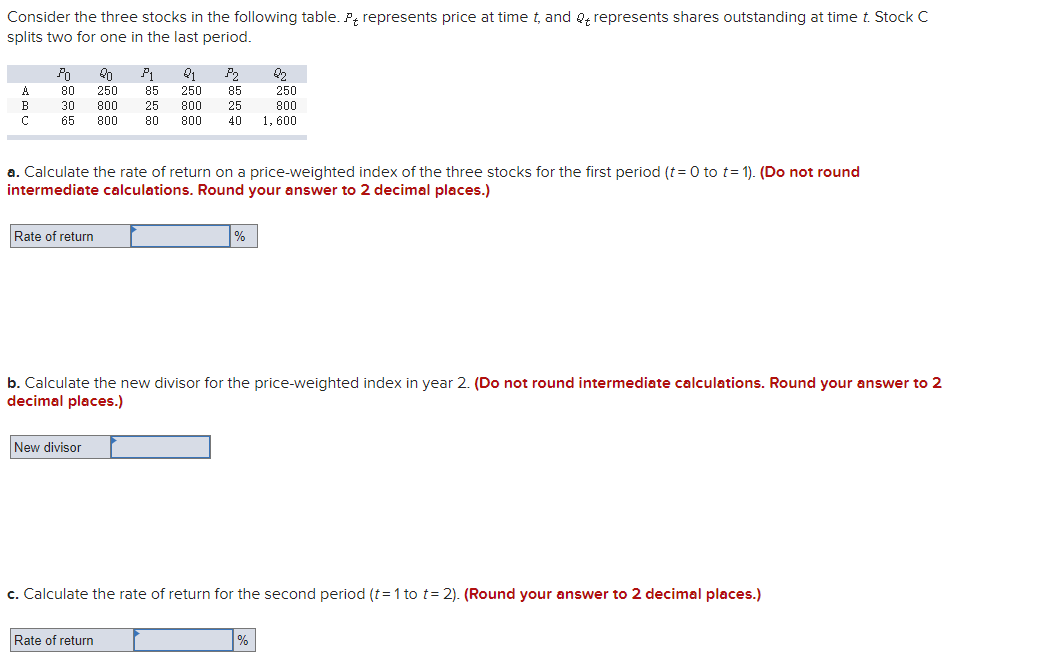Consider the three stocks in the following table. Pt represents price at time t, and represents shares outstanding at time t. Stock C splits two for one in the last period. A B с P₁ Q1 80 85 250 250 30 800 25 800 65 800 80 Po Rate of return P₂ New divisor a. Calculate the rate of return on a price-weighted index of the three stocks for the first period (t=0 to t=1). (Do not round intermediate calculations. Round your answer to 2 decimal places.) 85 25 800 40 1,600 Rate of return Q₂ % 250 800 b. Calculate the new divisor for the price-weighted index in year 2. (Do not round intermediate calculations. Round your answer to 2 decimal places.) c. Calculate the rate of return for the second period (t=1 to t=2). (Round your answer to 2 decimal places.) %
Consider the three stocks in the following table. Pt represents price at time t, and represents shares outstanding at time t. Stock C splits two for one in the last period. A B с P₁ Q1 80 85 250 250 30 800 25 800 65 800 80 Po Rate of return P₂ New divisor a. Calculate the rate of return on a price-weighted index of the three stocks for the first period (t=0 to t=1). (Do not round intermediate calculations. Round your answer to 2 decimal places.) 85 25 800 40 1,600 Rate of return Q₂ % 250 800 b. Calculate the new divisor for the price-weighted index in year 2. (Do not round intermediate calculations. Round your answer to 2 decimal places.) c. Calculate the rate of return for the second period (t=1 to t=2). (Round your answer to 2 decimal places.) %
Managerial Economics: Applications, Strategies and Tactics (MindTap Course List)
14th Edition
ISBN:9781305506381
Author:James R. McGuigan, R. Charles Moyer, Frederick H.deB. Harris
Publisher:James R. McGuigan, R. Charles Moyer, Frederick H.deB. Harris
Chapter5: Business And Economic Forecasting
Section: Chapter Questions
Problem 2E
Related questions
Question

Transcribed Image Text:Consider the three stocks in the following table. P represents price at time t, and represents shares outstanding at time t. Stock C
splits two for one in the last period.
A
B
с
P
20
250
80
P₁ 21
85 250
25
85
30 800
800 25
65 800 80 800 40
Rate of return
P2
a. Calculate the rate of return on a price-weighted index of the three stocks for the first period (t=0 to t= 1). (Do not round
intermediate calculations. Round your answer to 2 decimal places.)
New divisor
%
Rate of return
Q2
b. Calculate the new divisor for the price-weighted index in year 2. (Do not round intermediate calculations. Round your answer to 2
decimal places.)
250
800
1,600
c. Calculate the rate of return for the second period (t=1 to t= 2). (Round your answer to 2 decimal places.)
%
Expert Solution
This question has been solved!
Explore an expertly crafted, step-by-step solution for a thorough understanding of key concepts.
Step by step
Solved in 4 steps with 1 images

Knowledge Booster
Learn more about
Need a deep-dive on the concept behind this application? Look no further. Learn more about this topic, economics and related others by exploring similar questions and additional content below.Recommended textbooks for you

Managerial Economics: Applications, Strategies an…
Economics
ISBN:
9781305506381
Author:
James R. McGuigan, R. Charles Moyer, Frederick H.deB. Harris
Publisher:
Cengage Learning


Brief Principles of Macroeconomics (MindTap Cours…
Economics
ISBN:
9781337091985
Author:
N. Gregory Mankiw
Publisher:
Cengage Learning

Managerial Economics: Applications, Strategies an…
Economics
ISBN:
9781305506381
Author:
James R. McGuigan, R. Charles Moyer, Frederick H.deB. Harris
Publisher:
Cengage Learning


Brief Principles of Macroeconomics (MindTap Cours…
Economics
ISBN:
9781337091985
Author:
N. Gregory Mankiw
Publisher:
Cengage Learning

Essentials of Economics (MindTap Course List)
Economics
ISBN:
9781337091992
Author:
N. Gregory Mankiw
Publisher:
Cengage Learning

Exploring Economics
Economics
ISBN:
9781544336329
Author:
Robert L. Sexton
Publisher:
SAGE Publications, Inc

Managerial Economics: A Problem Solving Approach
Economics
ISBN:
9781337106665
Author:
Luke M. Froeb, Brian T. McCann, Michael R. Ward, Mike Shor
Publisher:
Cengage Learning